Introduction
Rice paper has gained popularity worldwide as a versatile and lightweight food wrap, commonly used in dishes like spring rolls and summer rolls. But is rice paper good for weight loss? Many health-conscious individuals are turning to rice paper due to its low-calorie content and gluten-free properties. However, understanding its nutritional benefits, potential drawbacks, and how to incorporate it into a balanced diet is essential before making it a staple in your weight loss journey.
This article explores the role of rice paper in weight management, its health benefits, potential disadvantages, and expert tips on how to use it effectively while maintaining a healthy diet.
Understanding Rice Paper
What is Rice Paper?
Rice paper is a thin, translucent edible wrapper made primarily from rice flour, water, and tapioca or salt. Originating from Asian cuisine, it is commonly used to wrap fresh ingredients, including vegetables, shrimp, tofu, and lean meats, making it an excellent choice for light, refreshing meals.
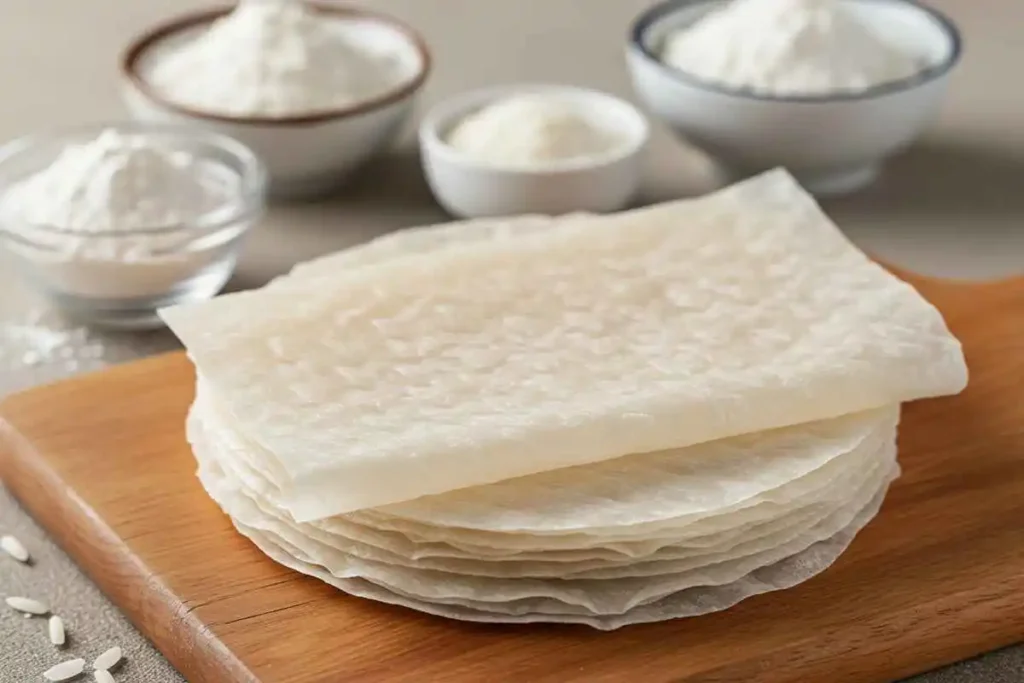
Unlike wheat-based wraps, rice paper has a unique texture that turns soft and pliable when dipped in water. It is naturally gluten-free, making it a preferred option for people with gluten sensitivities or those following a gluten-free diet.
Nutritional Composition of Rice Paper
Rice paper is known for its minimal ingredients and simple nutritional profile. A typical rice paper sheet (approximately 22 cm in diameter) contains:
- Calories: 30-40 kcal
- Carbohydrates: 8-10g
- Protein: 0.5-1g
- Fat: Less than 0.5g
- Sodium: 20-50mg (varies by brand)
Rice paper is low in fat and calories, making it a great alternative to traditional high-calorie wraps. However, it lacks fiber, protein, and essential nutrients, so the fillings you choose will determine its overall health benefits.
Rice Paper in Weight Loss Diets
Low-Calorie Content
One of the main reasons why rice paper is good for weight loss is its low-calorie nature. Compared to tortillas, pita bread, or even sushi rolls, rice paper contains fewer calories per serving. This allows you to enjoy multiple rolls without exceeding your daily caloric intake.
For instance, a whole wheat tortilla can contain over 150 calories, whereas two rice paper rolls filled with lean proteins and vegetables may only contain around 100-150 calories. This makes rice paper an ideal choice for those looking to control their calorie intake.
Low-Fat and Low-Sodium Benefits
Unlike deep-fried spring roll wrappers or other processed wraps, rice paper has little to no fat when consumed in its natural form. Additionally, the sodium content is relatively low, especially when compared to processed bread, which can contribute to bloating and water retention.
Gluten-Free and Vegan-Friendly Options
Rice paper is naturally gluten-free, making it a safe option for individuals with celiac disease or gluten intolerance. Moreover, it can be used to create delicious vegan and vegetarian-friendly meals, filled with tofu, avocado, fresh vegetables, and plant-based protein sources.
Comparison with Other Wrappers (e.g., Tortillas, Bread)
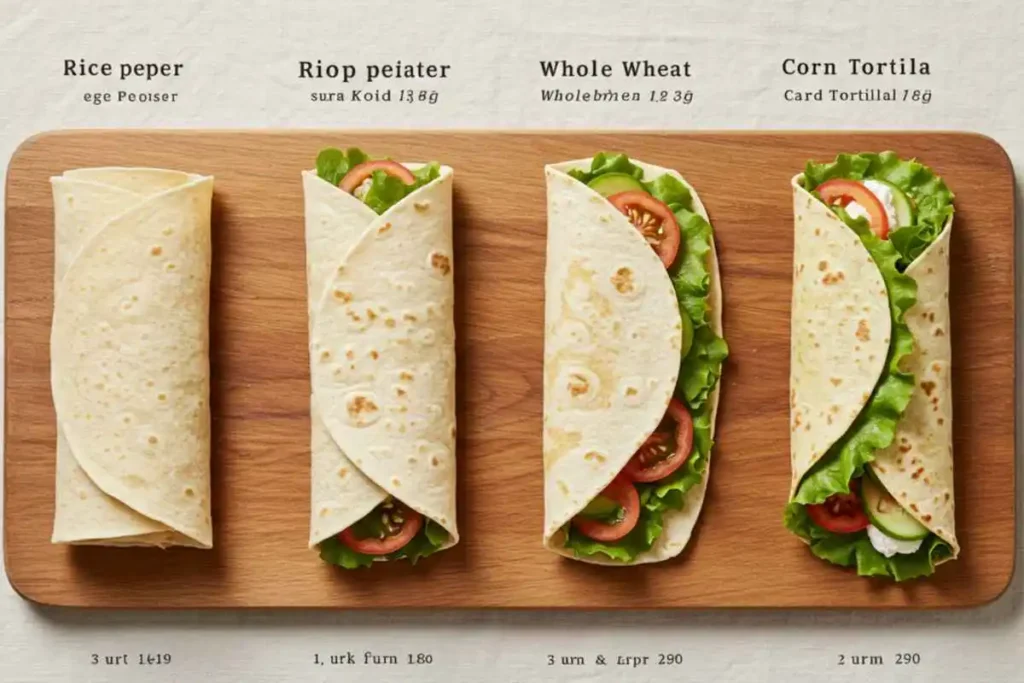
| Wrap Type | Calories (Per Sheet) | Carbs | Fat | Gluten-Free |
|---|---|---|---|---|
| Rice Paper | 30-40 kcal | 8-10g | <0.5g | Yes |
| Whole Wheat Tortilla | 150-200 kcal | 25-30g | 3-5g | No |
| Corn Tortilla | 50-70 kcal | 12-15g | 1-2g | Yes |
| Traditional Spring Roll Wrapper (Fried) | 200-300 kcal | 25-35g | 10-15g | No |
As seen in the comparison, rice paper has a clear advantage when it comes to caloric content and fat levels, making it a better choice for weight loss than traditional wraps.
Health Benefits of Rice Paper Rolls
High Fiber Content from Vegetable Fillings
Although rice paper itself is low in fiber, it is typically used to wrap fresh vegetables, which are rich in fiber. Fiber plays a crucial role in weight loss as it helps:
- Improve digestion and prevent constipation
- Keep you full for longer, reducing overall calorie intake
- Regulate blood sugar levels and prevent cravings
To maximize the fiber content of rice paper rolls, fill them with leafy greens (lettuce, spinach), shredded carrots, cucumbers, and bell peppers. These ingredients enhance the nutritional value of the meal while keeping it low in calories.
Protein Sources in Rice Paper Rolls
Protein is essential for muscle maintenance, metabolism, and satiety. A well-balanced rice paper roll should contain a good source of lean protein to support weight loss. Some excellent protein options include:
- Grilled chicken or turkey – High in protein and low in fat
- Shrimp – Low-calorie seafood packed with nutrients
- Tofu or tempeh – Great plant-based protein sources
- Eggs – Provide high-quality protein and essential nutrients
Including a protein source in your rice paper rolls can help prevent hunger pangs and reduce overall calorie consumption throughout the day.
Incorporation of Healthy Fats
Many people assume that all fats are bad, but healthy fats are necessary for overall well-being and weight loss. Rice paper rolls can be filled with sources of healthy fats, such as:
- Avocado – Packed with monounsaturated fats, which aid in fat loss
- Chia seeds – Provide fiber and omega-3 fatty acids
- Nuts & seeds (crushed almonds, sunflower seeds) – Offer essential nutrients and enhance satiety
A moderate amount of healthy fats helps regulate metabolism and curb cravings for unhealthy snacks.
Vitamins and Minerals from Fresh Ingredients
Rice paper rolls allow for a nutrient-dense meal, as they are typically packed with fresh vegetables and proteins. Some key vitamins and minerals found in common rice paper fillings include:
- Vitamin C (from bell peppers, carrots) – Boosts immunity and skin health
- Iron (from leafy greens, tofu) – Supports oxygen transport in the blood
- Omega-3 fatty acids (from seafood, nuts) – Beneficial for brain and heart health
By choosing colorful and nutrient-rich fillings, rice paper rolls become a powerhouse of essential vitamins and minerals.
Potential Drawbacks
While rice paper has many benefits, there are some potential downsides to consider when including it in a weight loss diet.
Overconsumption of Carbohydrates
Although rice paper is low in calories, it is still a carbohydrate-based food. Overconsumption of carbs—especially when not balanced with protein and fiber—can lead to:
- Blood sugar spikes
- Increased cravings for sugary foods
- Excess calorie intake leading to weight gain
To prevent this, it is essential to balance rice paper rolls with lean proteins, fiber, and healthy fats rather than relying on high-carb ingredients alone.
High-Calorie Fillings to Avoid
Rice paper itself is not fattening, but what you put inside it matters. Some ingredients can turn a low-calorie roll into a high-calorie meal. Here are fillings to avoid or limit:
Fried ingredients (deep-fried tofu, tempura shrimp) – Adds unnecessary calories and unhealthy fats
Excess sauces (peanut sauce, mayonnaise) – Can double the calorie count of a roll
Too much rice or noodles – Increases the carbohydrate load significantly
To keep rice paper rolls healthy and weight-loss-friendly, opt for fresh, unprocessed ingredients and use sauces in moderation.
Tips for Incorporating Rice Paper into a Weight Loss Plan
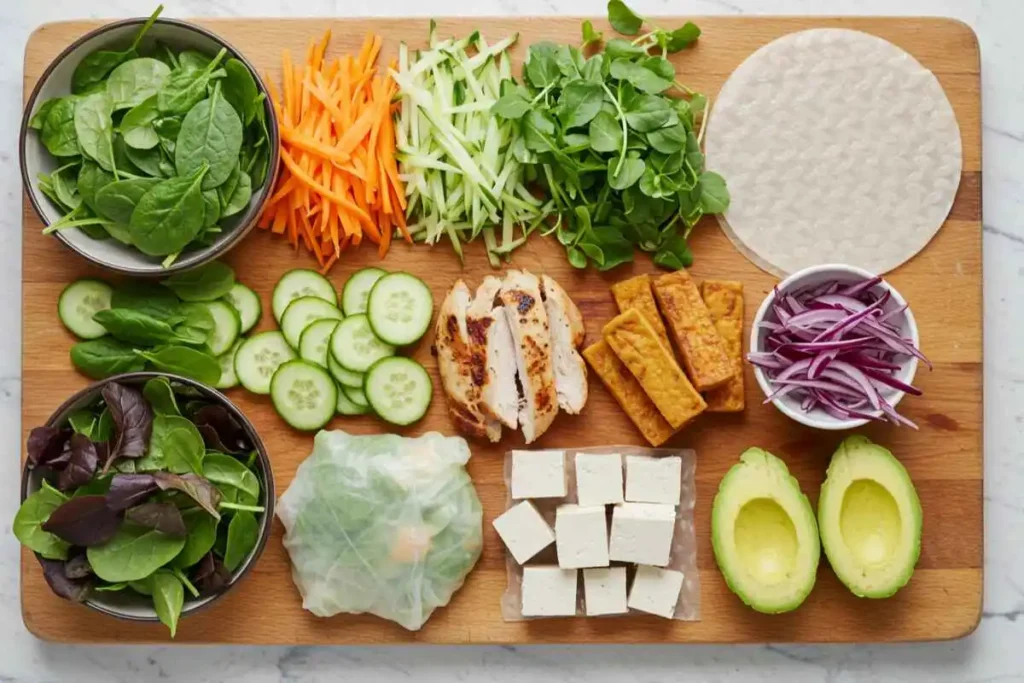
Choosing Low-Calorie Fillings
To make rice paper rolls effective for weight loss, it’s crucial to choose low-calorie, nutrient-dense fillings. Some of the best options include:
Leafy greens (lettuce, spinach, cabbage) – Low in calories, high in fiber
Lean proteins (grilled chicken, shrimp, tofu) – Keeps you full longer
Colorful vegetables (bell peppers, cucumbers, carrots, radish) – Packed with vitamins
Healthy fats (avocado, chia seeds, crushed nuts) – Supports metabolism and satiety
Avoid using fried ingredients, excessive sauces, and too much rice or noodles, as they can increase calorie intake and reduce the weight loss benefits of rice paper rolls.
Portion Control Strategies
Even though rice paper is low in calories, portion control is still key to successful weight loss. Here’s how to avoid overeating:
- Stick to 2-3 rice paper rolls per meal, depending on the calorie content of the fillings.
- Avoid overeating by using smaller plates and focusing on mindful eating.
- Pair rice paper rolls with a light soup or salad to add volume to your meal without excess calories.
- Use herbs and spices instead of calorie-heavy sauces to enhance flavor.
Meal Prepping with Rice Paper Rolls
Rice paper rolls are great for meal prepping, making healthy eating easier throughout the week. Follow these tips:
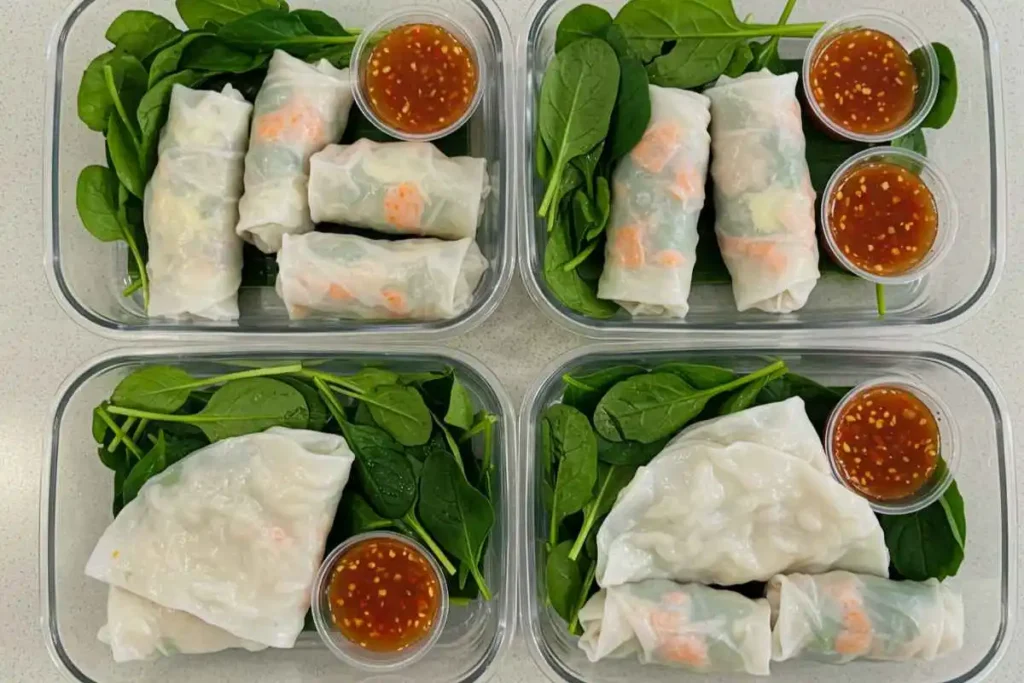
Prepare ingredients ahead of time – Chop vegetables and cook proteins in advance.
Store rolls properly – Keep them in an airtight container with a damp paper towel to prevent drying.
Make a variety of rolls – Use different protein sources and vegetables to avoid boredom.
Prepare a light dipping sauce – Use a mix of low-sodium soy sauce, lime juice, and chili flakes instead of high-calorie peanut sauce.
Pairing Rice Paper Rolls with Balanced Meals
For optimal nutrition and weight loss, rice paper rolls should be part of a well-balanced diet. Consider pairing them with:
- A side of lean protein (grilled fish, eggs, tofu)
- A bowl of clear vegetable soup for extra hydration and fiber
- A serving of healthy fats (such as a small handful of nuts or avocado slices)
- A refreshing herbal tea instead of sugary beverages
This approach ensures balanced macronutrients (proteins, carbs, and fats) while keeping your meal light and nutritious.
Frequently Asked Questions (FAQs)
Are rice paper rolls healthier than sushi rolls?
Yes! Rice paper rolls typically contain fewer calories and less sodium than sushi rolls, which often include white rice, added sugar, and high-sodium soy sauce.
Can I eat rice paper rolls every day?
Yes, but it’s essential to choose healthy fillings and control portions. Eating rice paper rolls with balanced nutrients daily can support weight loss, but relying solely on them may lead to nutritional deficiencies.
What are some low-calorie fillings for rice paper rolls?
Some great options include lettuce, cucumbers, carrots, grilled chicken, shrimp, tofu, and avocado. Avoid calorie-dense sauces and fried ingredients.
How many rice paper rolls should I eat in one meal?
It depends on the caloric content of the fillings, but 2-3 rice paper rolls per meal is generally a good portion for weight loss.
Are there any gluten-free alternatives to rice paper?
Yes! You can use lettuce leaves, nori seaweed sheets, or thinly sliced cucumber as gluten-free, low-carb alternatives.
Is rice paper good for a diet?
Yes, rice paper is low in calories and fat, making it a great option for a healthy diet. However, the healthiness depends on the fillings and portion sizes.
What are the disadvantages of rice paper?
Rice paper is low in fiber and protein, so it needs to be paired with nutrient-dense ingredients to make it a balanced meal. Additionally, consuming too many high-carb fillings can hinder weight loss progress.
How many calories are in rice paper?
A single sheet of rice paper contains 30-40 calories, but the overall calorie count of a roll depends on the fillings.
Is rice paper healthier than wraps?
Yes! Rice paper has fewer calories and less fat than most flour-based wraps, making it a healthier choice for weight loss.
Conclusion
So, is rice paper good for weight loss? Yes, but it depends on how you use it. Rice paper is a low-calorie, low-fat, gluten-free option that can be part of a healthy weight loss diet when paired with the right fillings.
To maximize its benefits:
Choose lean proteins, fiber-rich vegetables, and healthy fats
Avoid fried fillings, high-calorie sauces, and excessive carbohydrates
Practice portion control and balance your meals
By incorporating rice paper rolls into a well-balanced, nutrient-dense diet, you can enjoy delicious meals while staying on track with your weight loss goals.

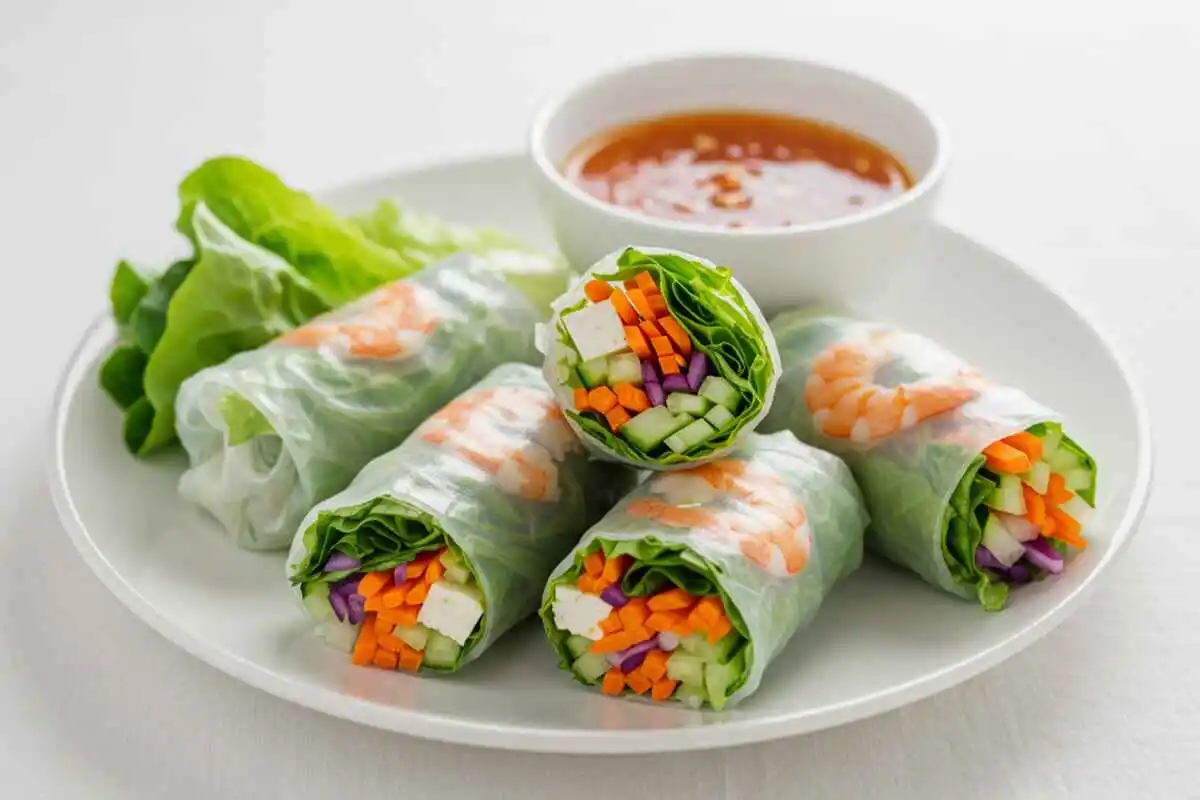
Muchas gracias. ?Como puedo iniciar sesion?